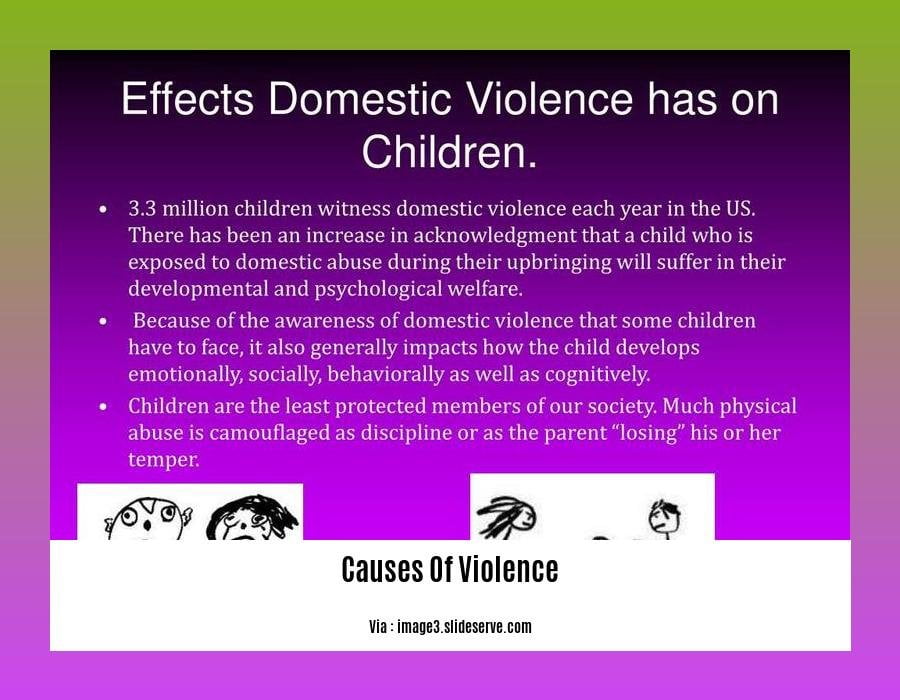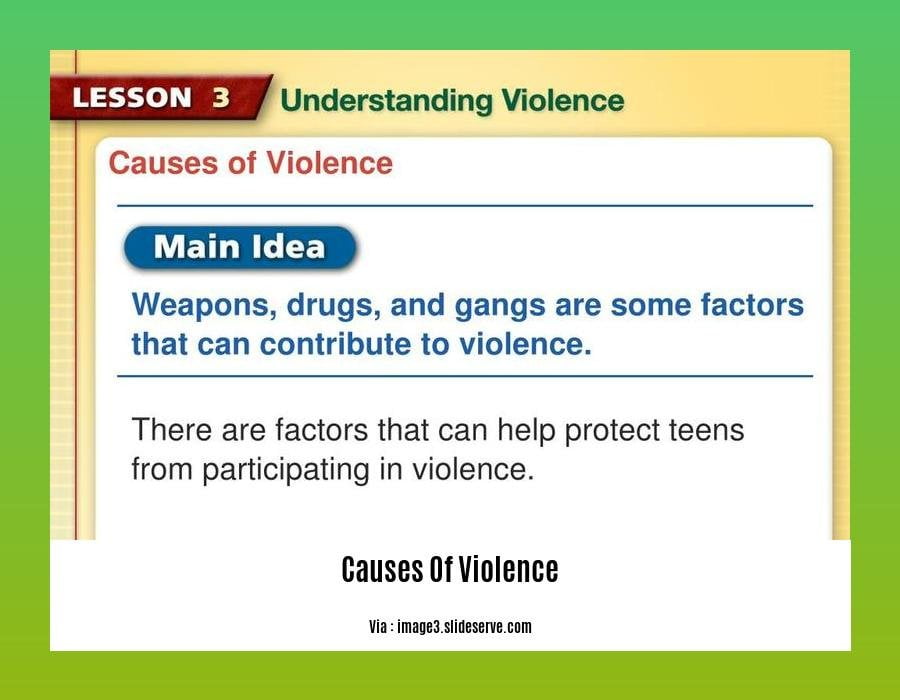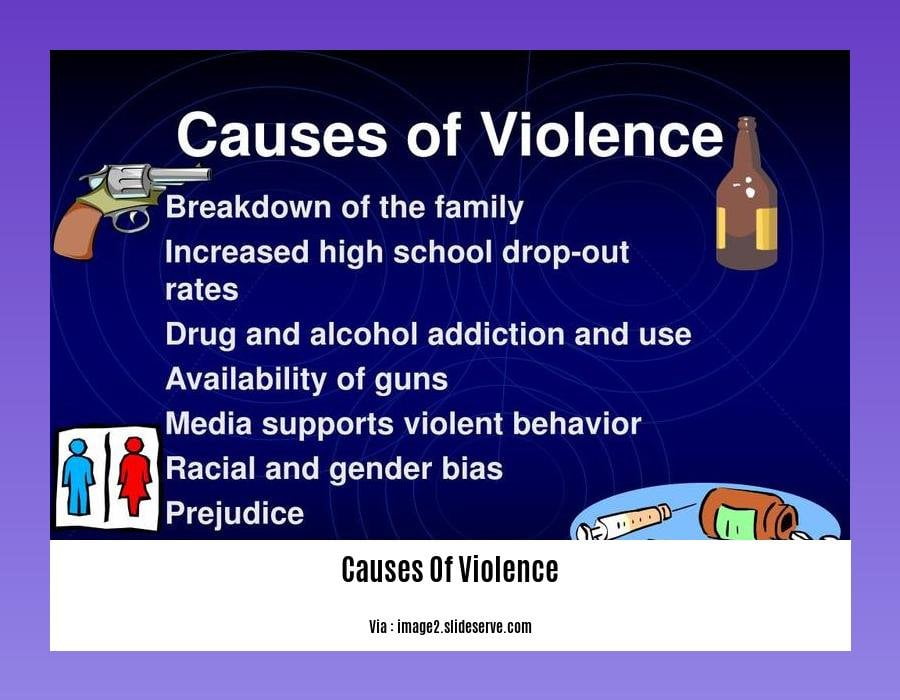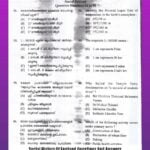Prepare to embark on an investigative journey into the enigmatic origins of violence with “Unraveling the Causes of Violence: A Journalist’s Perspective.”
Key Takeaways:
- Violence stems from a complex interplay of individual, environmental, and societal factors.
- Individual predispositions, such as neurochemical imbalances and personality traits, can contribute to violent behavior.
- Childhood trauma, peer influence, and exposure to violence in the home or community can shape individual behaviors.
- Societal factors like poverty, inequality, and cultural norms condoning violence are significant contributors.
- Situational triggers, such as arguments or poor self-control, can escalate into violent incidents.
- Age and sex play a role, with certain demographics being more prone to violent behavior.
Causes of Violence

Violence is a complex problem. There is no single cause but rather a combination of factors, such as:
Biological Factors
- Genetic predisposition
- Neurochemical imbalances
- High testosterone levels
Psychological Factors
- Personality traits (e.g., lack of empathy)
- Cognitive deficits
- Childhood trauma
Social Factors
- Poverty
- Inequality
- Discrimination
- Peer influence
- Lack of opportunity
Environmental Factors
- Witnessing violence
- Exposure to media violence
- Lack of safe housing
Situational Factors
- Arguments
- Poor self-control
Understanding the causes of violence is complex. Still, it is critical to addressing this issue. By working together, we can create a more peaceful world.
Delve into the history of violence to unravel the origins and evolution of violent behavior, shaping our understanding of its complexities. Explore types of violence to categorize and understand the diverse manifestations of harm, ranging from physical assault to psychological abuse. Uncover the impact of violence on society, examining its devastating ripple effects on individuals, communities, and nations, and explore strategies for prevention and healing.
Cultural and Historical Factors such as Exposure to Violence, Conflict, and Discrimination

Throughout history, societies have been shaped by violence, conflict, and discrimination, leaving lasting scars on individuals and communities. These cultural and historical factors play a significant role in perpetuating cycles of violence, reinforcing power imbalances, and eroding societal trust.
Historical and Structural Factors:
Colonization, slavery, and patriarchy have created power imbalances and resource disparities, contributing to cultural violence. These systems perpetuate discrimination and violence, creating a society where certain groups are marginalized and deprived of opportunities.
Cultural and Religious Beliefs:
Cultural and religious beliefs can reinforce discriminatory attitudes and behaviors. For example, beliefs about gender roles and societal norms can justify violence against women, LGBTQ+ individuals, or other marginalized groups. Such beliefs create a culture of impunity and undermine efforts to address violence effectively.
Consequences of Cultural Violence:
Cultural violence leads to social inequality and the denial of basic human rights. It erodes trust, social cohesion, and democratic values, destabilizing society. Discrimination and economic hardship can serve as triggers for violence, further escalating the cycle.
Key Takeaways:
- Historical and structural factors, such as colonization, slavery, and patriarchy, create power imbalances and contribute to cultural violence.
- Cultural and religious beliefs can reinforce discriminatory attitudes and perpetuate violence.
- Cultural violence leads to social inequality and the denial of basic human rights.
- It erodes trust, social cohesion, and democratic values, destabilizing society.
- Triggers such as discrimination or economic hardship can precipitate violence.
Citation:
- “Cultural Violence: Its Forms, Effects, and Solutions.” Social Psychology.Info, Accessed 22 September 2023.
Biological factors such as genetics and brain chemistry
Psychophysiological measures, such as heart rate and skin conductance, are linked to aggression. Brain abnormalities, especially in the prefrontal cortex and amygdala, are associated with criminal behavior. Genetic factors, including genetic polymorphisms and candidate genes, influence the risk of violent behavior.
Key Takeaways:
- Biological factors play a role in antisocial and criminal behavior.
- Psychophysiological measures are linked to aggression.
- Brain abnormalities are associated with criminal behavior.
- Genetic factors influence the risk of violent behavior.
Citation:
Ling, S., Umbach, R., & Raine, A. (2019). Biological explanations of criminal behavior. Journal of Criminal Justice and Popular Culture, 26(3), 227-242.
Political and Institutional Factors: Unraveling the Role of Government Oppression, Corruption, and Lack of Accountability
Political and institutional factors, such as government oppression, corruption, and lack of accountability, play a crucial role in shaping the prevalence of violence. These interlocking elements create a complex web of power imbalances, resource disparities, and social injustice that can fuel violence at both the individual and societal levels.
Corruption involves the misuse of public power or resources for private gain. This can manifest in various forms, such as bribery, embezzlement, and nepotism. Corruption undermines trust in government, erodes public institutions, and creates opportunities for violence as individuals and groups seek to protect their ill-gotten gains.
Lack of accountability allows those in power to act with impunity, fostering a climate where violence can flourish. When individuals perceive that they can commit violent acts without fear of consequences, it emboldens them to engage in further violence. This lack of accountability can result from weak rule of law, ineffective law enforcement, and a lack of transparency in government processes.
Government oppression refers to the use of excessive force or coercion by the state against its citizens. This can include arbitrary arrests, torture, and extrajudicial killings. Oppressive regimes often resort to violence to suppress dissent, maintain control, and silence opposition. The resulting fear and climate of impunity can lead to increased levels of violence within society.
Key Takeaways:
- Political and institutional factors, including government oppression, corruption, and lack of accountability, significantly contribute to violence.
- Corruption undermines trust in government, creates opportunities for violence, and erodes public institutions.
- Lack of accountability allows those in power to act with impunity, fostering a climate where violence can flourish.
- Government oppression uses excessive force or coercion to suppress dissent and maintain control, leading to increased violence.
- Addressing these political and institutional factors is crucial for preventing and reducing violence in society.
Most Relevant URL Source:
- Accountability and Corruption – The World Bank:









